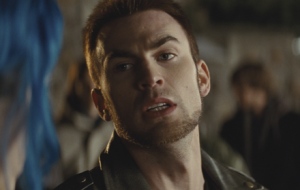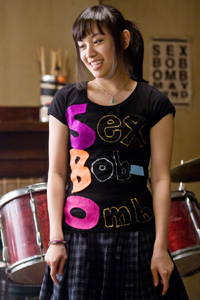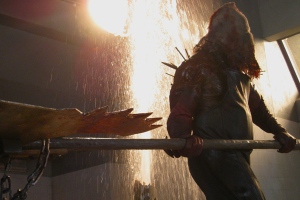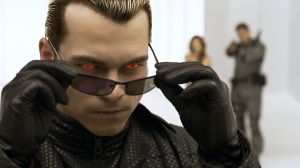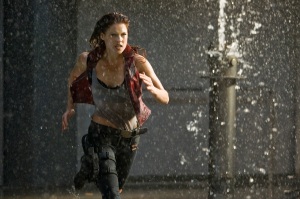My uncle used to live in Bermuda where he learnt a very handy phrase that has proven invaluable in a wide variety of situations in day-to-day life that I would like to share with you. Dilligas. It’s an acronym for Do I Look Like I Give A Shit? What a wonderful word it is. Please share it with as many people as you can.
I bring this up because what I found essentially wrong with Scott Pilgrim VS. The World was that the attitude of all the characters in the film, bar one, can be summed up as Dilligas. The plot is extremely straightforward. 22-year-old unemployed slacker Scott Pilgrim (Michael Cera) is dating 17-year-old high school girl Knives Chau (Ellen Wong). That doesn’t stop Scott from falling ass-over-tip for new-girl-in-town Ramona Flowers (Mary Elizabeth Winstead). However, in order to be able to date Ramona, he must first defeat her Seven Evil Exes. He does so. The end.
That’s the whole shebang right there. It is linear, very simple and untainted by the blemishes of suspense, surprises, twists, turns or even just an ill-considered Deus Ex Machina. There are some jokes scattered sparingly throughout the dialogue that should raise a smile, many of the best ones involving Scott’s gay roommate played by Kieran Culkin, but a handful of quips don’t really add up to a compelling screenplay.
While the opposite of a protagonist is usually an antagonist, Scott Pilgrim is the negation of a protagonist. He is less active than your average sponge when it’s tuckered out from a long day being absorbent and swaying gently in the ocean currents. Scott is entirely reactive and makes only one decision of any consequence in the entire story – to introduce himself to Ramona. Every other decision is made for him or forced upon him to the extent that in the final scene of the whole movie, Scott does not choose which girl he ends up with out of Ramona and Knives, the decision is made for him. Perhaps Scott considered being indecisive but then thought he’d just wait and see what happens. He is an emotional infant, eager to be told what to think and feel. Why is this character supposed to be appealing or engaging?
The whole enterprise is permeated by an attitude of disaffection so all-pervasive that no one cares about anything.
When Scott receives the email from the First Evil Ex announcing their impending fight he says, ‘This is so…boring’ and deletes it. Everything is boring to Scott and his friends. He plays in a terrible band called Sex Bob-omb and they all go to a party just so, in the words of their drummer Kim, they can have something to complain about. Later on Scott leaves the band, the only thing he actually has going on in his life, but clearly it never meant anything to him anyway. He can’t be bothered to be bothered. What does he do all day? He has no job, no ambition, nothing. The script completely avoids the issue of why girls are attracted to him in the first place. He has nothing to offer – certainly not passion. In his passive fashion, it falls to Ramona to seduce Scott. He just waits for the adult to take command.
The emotional range on display runs the gamut from wry detachment to bored resignation. Everything that happens, no matter how outrageous, is greeted by the characters with no more than an archly raised eyebrow. The only character that ever shows any passion or enthusiasm about anything is an object of ridicule – Knives Chau. Her youthful excitement for Sex Bob-omb is meant to be laughable – she screams when they come on stage and passes out from sheer over-stimulation. Everyone else just looks at her, eyebrows cocked. What sort of loser actually shows enthusiasm for anything in public anyway? Oh right, an Asian one, because Asian kids aren’t cool. They’re dorks. The singer of Sex Bob-omb even explicitly says that he wants Knives to geek out over the band. Those geeky Asian kids, with their maths and their good grades, they’re freaking hilarious.
As a filmmaker Edgar Wright has shown considerable style in the past. Shaun Of The Dead is a great zombie movie and his TV show Spaced was inventive and often very funny. The basis for the visual style of Scott Pilgrim VS. The World is the aesthetic of video games, particularly fighting games, which is both under-whelming and yet completely appropriate. There is nothing at stake when you play a video game, especially on a home console where you don’t have to keep feeding coins into the machine. If you lose, you just re-start. Defeat has no meaning when you can just re-load where you left off. That’s the biggest problem with the movie. Despite all the onscreen fighting, there is no sense of jeopardy in the battles. The fights take place in an aura devoid of pain or even the possibility of injury. Scott gets kicked about, thrown through the air and walloped in his all-too punchable face but he never actually gets hurt. When he is defeated, he simply returns to the start of the level and picks up from there, just like playing a video game. Some sense of danger, of there being a price to defeat and perhaps even a cost to victory, would add some much needed tension to the proceedings.
All the fighting serves no actual purpose but to fill time as the plot inches slowly in a straight line to its inexorable, inevitable conclusion of boy gets girl (and hopefully syphilis). A good fight scene is a drama unto itself, a dialogue between two bodies, an exchange of techniques and a chance for the hero to defeat both his opponent and himself. In Scott Pilgrim VS. The World, the fight scenes are eye candy, devoid of drama or menace. It’s all so hip and post-modern that it collapses under the weight of all the inter-textual references that attempt to fill the void at the heart of the film. I’d be angry if I wasn’t so lethargic. You know, like the cool kids. I mean seriously, do I look like I give a shit? No? Thank crap for that.

